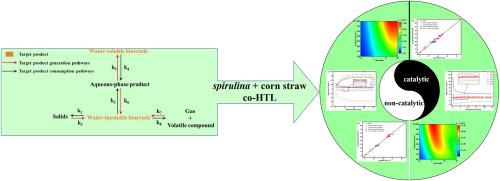螺旋藻+玉米秸秆共水热液化:反应机理、途径及动力学研究
IF 6.2
2区 工程技术
Q2 ENERGY & FUELS
引用次数: 0
摘要
本文建立了螺旋藻+玉米秸秆共水热液化(co-HTL)过程的全球动力学通路网络和定量反应动力学模型,并应用该模型准确表征了螺旋藻+玉米秸秆共水热液化(co-HTL)过程中的产物变化和迁移行为。反应动力学模型包括原料分解生成不溶于水的生物原油,以及几种不同产物之间的相互转化过程。该模型能较准确地描述不同产品产量的时间变化趋势。通过对反应速率常数ki和活化能Ea的分析,确定了非催化体系和催化体系中水不溶性生物原油转化为固体和水相产物转化为水溶性生物原油的速率控制步骤。最后,利用模型拟合结果得到的最优动力学参数,准确预测了不同产物产率在较宽温度和时间范围内的分布和变化。本文章由计算机程序翻译,如有差异,请以英文原文为准。

Co-hydrothermal liquefaction of spirulina + corn straw: Reaction mechanism, pathways and kinetic studies
In this work, a global kinetic pathway network and quantitative reaction kinetic model have been proposed and applied to accurately present the product changes and migratory behavior in co-hydrothermal liquefaction (co-HTL) of spirulina + corn straw. The reaction kinetic model involves the decomposition of feedstock to produce water-insoluble biocrude, as well as the mutual transformation processes between several different products. Moreover, the proposed model can accurately describe the temporal variation trends of different product yields. By analyzing reaction rate constant ki and activation energy Ea, the rate-controlling steps for the non-catalytic and catalytic systems are determined as the pathway of water-insoluble biocrude to solids and that of aqueous-phase products converting to water-soluble biocrude, respectively. Finally, the optimal kinetic parameters obtained from model fitting outcomes were used to accurately predict the distribution and variation of different product yields over a wider range of temperature and time.
求助全文
通过发布文献求助,成功后即可免费获取论文全文。
去求助
来源期刊

Journal of The Energy Institute
工程技术-能源与燃料
CiteScore
10.60
自引率
5.30%
发文量
166
审稿时长
16 days
期刊介绍:
The Journal of the Energy Institute provides peer reviewed coverage of original high quality research on energy, engineering and technology.The coverage is broad and the main areas of interest include:
Combustion engineering and associated technologies; process heating; power generation; engines and propulsion; emissions and environmental pollution control; clean coal technologies; carbon abatement technologies
Emissions and environmental pollution control; safety and hazards;
Clean coal technologies; carbon abatement technologies, including carbon capture and storage, CCS;
Petroleum engineering and fuel quality, including storage and transport
Alternative energy sources; biomass utilisation and biomass conversion technologies; energy from waste, incineration and recycling
Energy conversion, energy recovery and energy efficiency; space heating, fuel cells, heat pumps and cooling systems
Energy storage
The journal''s coverage reflects changes in energy technology that result from the transition to more efficient energy production and end use together with reduced carbon emission.
 求助内容:
求助内容: 应助结果提醒方式:
应助结果提醒方式:


